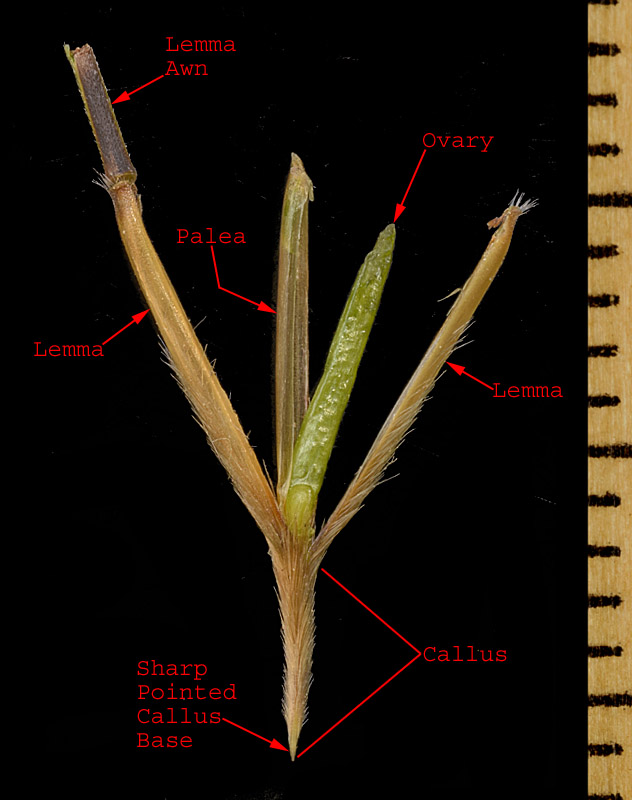 |
Stipeae: Answers to key questions
leading to this tribe.
 | Mature inflorescence, if breaking into units, then the units not as
below; NOT [Mature inflorescence breaking into spikelet units consisting
of a sessile fertile spikelet, a hairy pedicel with or without a sterile
spikelet at tip, and a hairy rachis joint, all arising at the same point
(a node) in specialized panicle branches called rames] |
 | Spikelets not as below; sterile florets if present, either located
distal to the fertile floret(s) on the rachilla or paired and attached
at the base of a single fertile floret, not paired with the upper glume
as below; lemma and palea variously textured, enclosing the flower or
not; disarticulation usually above the glumes; NOT [Spikelets usually
dorsally compressed, appearing 1-flowered but containing 1 fertile
floret and 1 sterile floret, the latter attached to the base of fertile
floret opposite the upper glume, resembling the upper glume, and
together with the upper glume enveloping the fertile floret; lower
glumes minute (sometimes absent) to 3/4 as long as upper glumes and
typically wrapping most of the way around the pedicel at base; fertile
floret seed-like with chartaceous-indurate lemma and palea enclosing
flower and fruit; disarticulation below the glumes with rare exceptions] |
 | Spikelets 1 to many-flowered, subtended by a pair of glumes (only 1 on
lateral spikelets in Lolium); palea margins enclosed or not; plants of
dry or wet habitats; NOT [Spikelets 1-flowered, lacking glumes; margins
of the palea tightly enclosed by the lemma margins on female or perfect
florets; plants of wetlands, often emergent aquatic] |
 | Inflorescence not as below; if a terminal spike, then the lateral
spikelets attached edgewise to the rachis with inner (upper) glume
wanting (as in Lolium); NOT [Inflorescence a terminal spike with sessile
or subsessile spikelets attached broadside at nodes on opposite sides of
the rachis] |
 | Lemmas stiff to indurate, firmer than the glumes, surrounding the
palea and often overlapping along the margins, closed at the tip as well
as at the base, often pubescent; lemma awns (caducous or wanting in some
species) terete and encircled at the base by the closed tip of the
lemma; calluses usually pubescent, rarely glabrous; NOT [Lemmas and
lemma awns not as above; if lemma indurate and enveloping the floret,
then glumes distinctly dorsally compressed and calluses glabrous (as in
Milium)] |
 | Lemma awns 1, persistent or caducous; lemmas usually pubescent; NOT
[Lemma awns 3, persistent; lemma glabrous]
|
|
 |
Hesperostipa: Answers to key questions
leading to this genus (in tribe Stipeae).
 | Lemma awns 50-225 mm long; lemmas 7-25 mm long; callus 2-6 mm long,
sharp-tipped; glumes 15-45 mm long; NOT [Lemma awns 1-32+ mm long;
lemmas 1.5-7 mm long; callus to 2 mm long, blunt to pointed but not
sharp-tipped; glumes 2.5-13 mm long]
|
 |
Curtiseta: Answers to key questions
leading to this species (in genus Hesperostipa).
 | Lemma pubescence concentrated proximally and extending distally along
the margins or in lines between the nerves, the hairs usually brown and
about as dense as the callus hairs at least on the lower part of the
lemma (becoming less dense distally); lower glumes usually about equal
in width to the upper glumes, and long attenuate or with hair-like tip
< 1/2 the length of the body; lemma awns stout, strongly geniculate
on drying with a terminal segment up to 75 mm long and straight on
drying; NOT [Lemma pubescence ± evenly distributed throughout, the
hairs usually white and much less dense than the callus hairs (the lemma
hairs may be rubbed off in places on mature florets); lower glumes
usually narrower than the upper glumes, distinctly 3-nerved with wide
hyaline margins and a long hair-like tip that can be > 1/2 the length
of the body (these tips may break off with age); lemma awns slender,
weakly geniculate with a terminal segment 40-120 mm long and strongly
curling on drying] |
 | Lemmas <= 14 (15) mm
long; lemma pubescence extending distally along lemma margins primarily;
lemma awns 50-105 mm long; glumes <= 30 mm long; lower leaf sheaths
with hyaline margins; plants usually to 6.5 dm high, occasionally
taller; NOT [Lemmas >= 15 mm long; lemma pubescence extending distally along
lemma margins and often also between the nerves; lemma awns 90-190 mm
long; glumes >= (22) 29 mm long; lower leaf sheaths usually with
ciliate margins; plants 4.5-9 (14) dm high]
|
|
|

